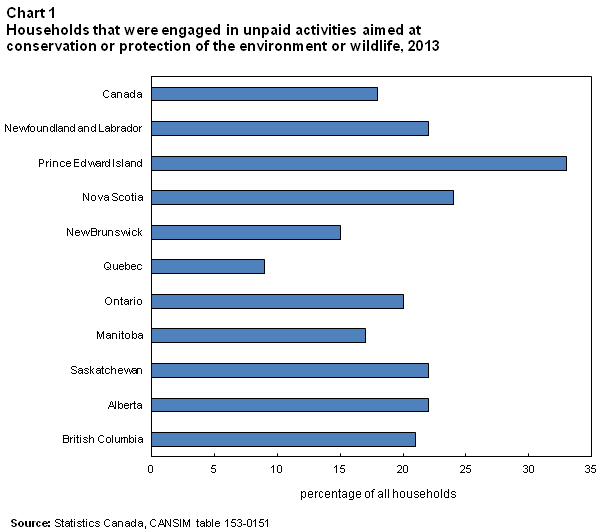Canadians and Nature: Environmental engagement, 2013
Archived Content
Information identified as archived is provided for reference, research or recordkeeping purposes. It is not subject to the Government of Canada Web Standards and has not been altered or updated since it was archived. Please "contact us" to request a format other than those available.
There are many ways citizens can become involved in the conservation and protection of the environment. They can, for example, donate money to an environmental conservation organization or volunteer to help clean up a park, or join an environmental group.
Overall engagement
Almost 1 in 5 (18%) Canadian households engaged in unpaid activities aimed at conservation or protection of the environment or wildlife. Households in Prince Edward Island were the most engaged with one-third of households reporting this, while those in Quebec were the least engaged (9%).
Household composition appears to make a difference when it comes to environmental engagement. In households where there are only people between the ages of 25 and 44, 16% reported some manner of environmental engagement. Households that included children and teens, however, were more than twice as likely (36%) to have engaged in these types of activities. Seniors-only households were the least likely to have done this, with 11% reporting this type of activity.
Activities undertaken as part of a group or independently
Environmental engagement activities can be undertaken as part of an organized group or on one’s own. Organized activities, can include beach or park clean-up days and unpaid help provided to schools, religious organizations, sports or community associations.
More than half (54%) of the households that reported engaging in unpaid activities aimed at conservation or protection of the environment or wildlife did so on behalf of a group or organization. Most of the households in Quebec that were engaged (68%) did so as part of a group, while about 37% of the households in Manitoba did so. Households with children and teens were more likely to have participated in group activities compared to adult-only households.
Independent actions, such as picking up litter and writing letters to political officials, are other ways individuals and households may engage in environmental conservation and protection activities.
Just over two-thirds of households (68%) that reported engaging in unpaid environmental engagement activities did so independently. Households in Saskatchewan were most likely to have done this with 81% of engaged households reporting this. Engaged households in Quebec (53%) were the least likely to have engaged in independent conservation and protection activities.
Engagement in independent activities was more frequently reported by households that did not include children or teens.

Cleanups
Cleaning up shorelines, beaches, rivers, lakes and roadsides are important conservation activities undertaken by just over 4 out of 10 engaged households (41%). Households in Prince Edward Island reporting this most frequently (67%), and households in Quebec reporting it least frequently (34%). Engaged households that included both teens and children were most likely to have participated (48%), while households with children 12 years of age and younger were least likely (35%) to have taken part in cleanup activities.
Monitoring
Monitoring and assessing wild species and natural habitats are an important part of nature conservation. Taking part in bird counts and similar activities, for example, is one way households can volunteer their time to help conserve nature. In 2013, 15% of engaged households reported they participated in this kind of activity. Households with only members between 45 and 64 years of age, and seniors-only households (65 years of age and over) were most likely to have done this (19% and 20%, respectively).
Teaching
Giving guided nature walks, chaperoning school trips to nature centres, and leading or assisting indoor courses on nature and the environment are examples of ways people can teach others about nature. Seven percent of all households in Canada reported that a member of the household volunteered their time to teach others about nature, with households in British Columbia and Manitoba most likely to have reported this (11% and 10%, respectively).
Start of text box
About the Households and the Environment Survey
The Households and the Environment Survey asks Canadian households about their activities and behaviours with respect to the environment. It covers a wide variety of topics including water and energy consumption and conservation, hazardous products used in the home, and the household’s interactions with nature. Data from the survey are used by governments to guide policies and programs, by researchers to learn more about Canadians and by individuals to see how they compare to the rest of the country.
The target population of the 2013 Households and the Environment Survey consisted of households in Canada, excluding households located in Yukon, Northwest Territories and Nunavut, households located on Indian Reserves or Crown lands, and households consisting entirely of full-time members of the Canadian Armed Forces. Institutions and households in certain remote regions were also excluded.
End of text box
Definitions, data sources and methods: survey number 3881. Available in CANSIM: tables 153-0151 to 153-0152. For more information, or to enquire about the concepts, methods or data quality of this release, contact us (toll-free 1-800-263-1136; 514-283-8300; infostats@statcan.gc.ca) or Media Relations (613-951-4636; statcan.mediahotline-ligneinfomedias.statcan@canada.ca).
Related topics: Canadian Nature Survey, Environment Canada. [http://www.biodivcanada.ca/default.asp?lang=En&n=2A0569A9-1]
- Date modified:
